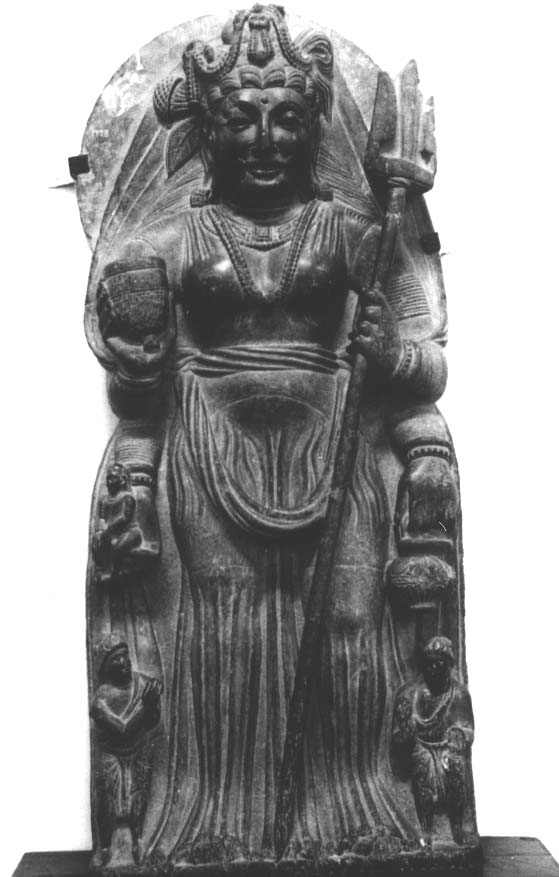 |
Sahri-Bahlol. Second to fifth century C.E.
Schist. H. 122 cm. Peshawar Museum.
Photo by Jennifer Rowan.
 |
This image of Hariti stands in high relief on a devotional stele, a plain nimbus behind her head. The figure is formal and rigidly frontal, flanked by two small worshippers. The goddess is four armed and holds the following attributes in each hand: trident; waterpot; footed cup; and tiny seated child.
Her garments are in the "wet" drapery style, the breasts and pubic region are emphasized by etched lines and stylized drapery folds. The lower skirt flares from knees to ground with many parallel folds. She wears a scarf that appears as flat, incised lines on her nimbus and then wraps around and over her upper arms at the elbows. A twisted sash binds the waist while a rope of similarly twisted fabric drapes in an unusual U-shape over the thighs.
Hariti's hair is parted in the center and arranged in neat parallel waves; her longer hair is looped up on the right side of her head. Behind the left side of her head, an ornamental pipal (?) leaf and flower appear. She wears an elaborate, high headpiece of looped jeweled strands. Her earlobes are extended with heavy earrings. Around her neck, she wears a thick rope of gems with large central beads in combination with a broad ornamental neckpiece with a square central amulet. All four arms are heavily braceleted, including her upper arms.
This figure has proved most problematic in terms of reliable identification in the context of Hariti iconography. This is due, in part, to the multiple arms, an anomaly in Gandharan imagery, but also because of the unusual array of attributes and stylistic features that cannot be correlated with any other Hariti image.
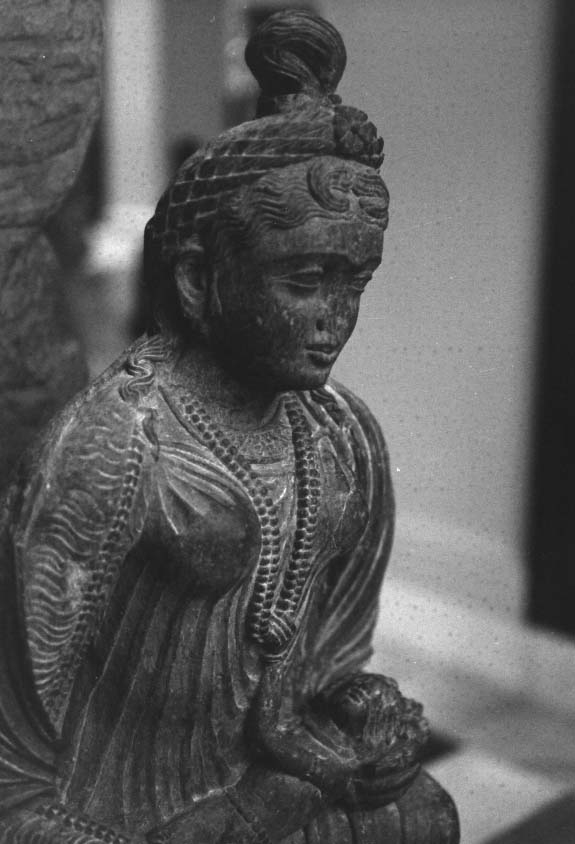 |
This sculpture of Hariti portrays her seated in palambapadasana on a backless throne, her feet resting flat on a carved footstool. She holds a naked, male child across her lap. Other figures (children?) cluster three to a side, one holding a parrot. A larger child sits in royal pose between her feet.
Hariti's breasts are accentuated by the tight, smooth casing of her garment; the nipples are visible. The skirt of the garment falls in folds between her spread knees but follows the bent angle of the leg instead of falling naturally with gravity. She wears a shawl over her left shoulder. The tight sleeves are full-length and ornate, distinguished by tight horizontal pleats or gathers in a wavy pattern. A narrow ornamental band or double line of beads runs down the length of each arm to the wrist.
Hariti wears a wide, flat jeweled necklace in combination with a rope of precious stones held by the child on her lap. Ankle bracelets are decorated with an incised crosshatched pattern, and round, ornamental bracelets or cuffs fit tightly around her wrists. One beaded earring is visible hanging from her left ear, and she wears a ring on the little finger of each hand. Her face is heartshaped, her nose has been broken off. She has a smooth, low brow with articulated eyelids and no pupils. Her hair is arranged in flat, stylized waves with a central part and forming a distinctive almond-pattern in center of her forehead. She wears a narrow woven wreath with a central rosette motif. Overhead, a section of her hair is looped high and fastened in place.
The influence is predominantly Iranian which is evident in the Parthian-style garments and dynamic surface ornamentation.
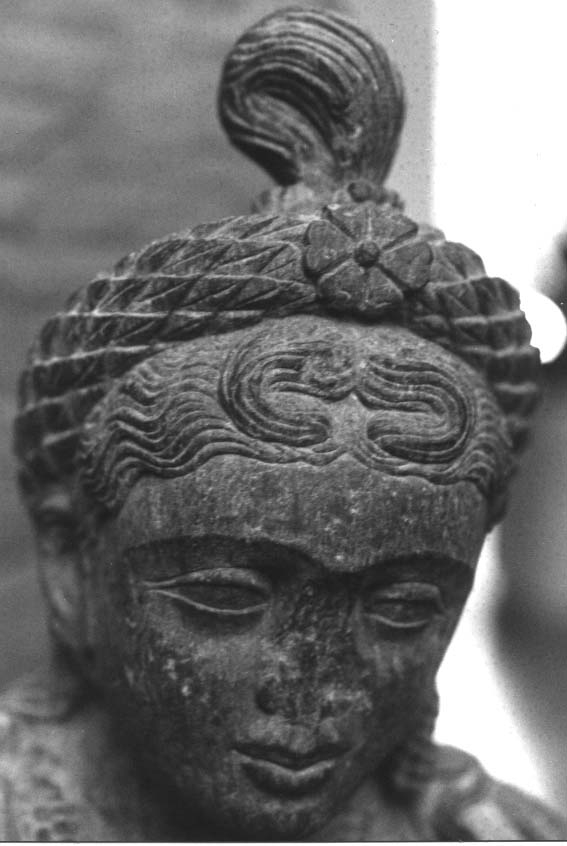 |
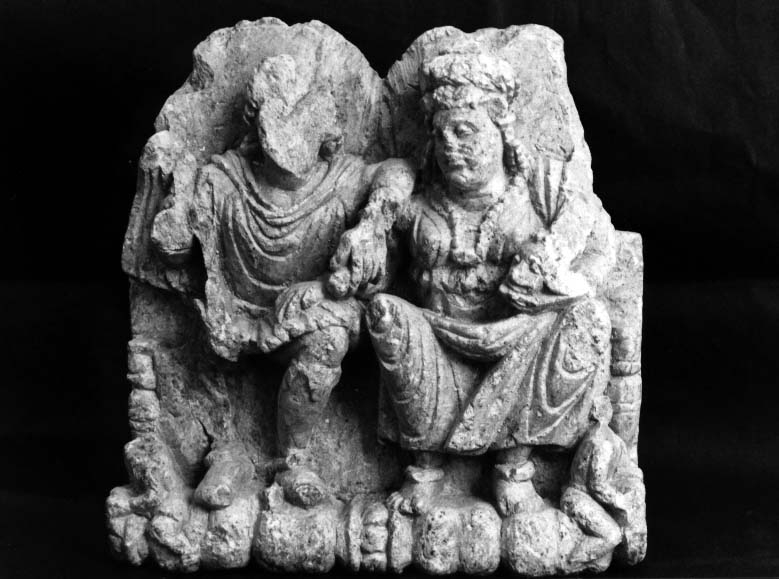 |
The tutelary pair is seated in palambapadasana; each has a halo and is dressed in Hellenistic garb. The male figure is missing his face, right arm from the elbow, and right leg. He is dressed in a long-sleeved (?), knee-length tunic with gathered or pleated skirt. He wears knee-high boots with the tops folded over in triangular flaps. He rests his left elbow on his partner's right shoulder and holds a small round object (a bag of money?) in his left hand. Nothing remains to confirm his other attribute, a staff or spear, but this is not contraindicated. In fact, the position of his right arm is consistent with similar pieces while a small residual piece on the base near the inside of his left foot might be the terminal tip.
His consort wears an ankle-length chiton, clasped at each shoulder and gathered high under the breasts. A braided laurel wreath sits high on her head; her hair is in curls over the forehead and then pulled back over her ears. She wears earrings, a long single strand of beads with a center amulet and large ankle bracelets. Her feet are bare. Her right hand rests on her consort's left thigh. She holds a cornucopia whose upper portion is missing; the terminal point simulates the head of an animal.
The outer legs of the double throne still survive and appear as turned or carved wood. The feet of the two deities rest on a base that consists of pots of money turned on their sides in sets of two and laid base to base. Schematic circles between two center-facing rims represent coins. Two small headless figures, one at each extreme side, straddle the outermost pots, holding onto the rims.
 |
Hariti stands with her right hand raised but damaged; a small child perches high on her left shoulder. The child's face is very crudely carved and ill-proportioned (perhaps designed to be viewed from below). The goddess is full-faced, with a slightly smiling expression. Her hair is arranged in a chignon at the back of her head. She wears a chiton clasped at each shoulder and gathered in folds between the breasts and into a high waist. A scarf hangs in a long diagonal drape from her left side down and across to her right knee and back up behind. Below the hem of her dress, an underskirt flares over the tops of both feet. The base of the bracket is a simple plinth decorated with a sawtooth pattern.
|
|
Hariti sits in formal palambapadasana on an elaborate throne with a small footstool. Her head is framed by a plain nimbus, and she is flanked by two children at her shoulders, another standing at each knee and two seated beside her footstool. A final (seventh?) child is seated across her lap.
Hariti holds a cluster of grapes and leaves in her raised (damaged) right hand and simulates abhaya mudra. She is dressed in a long gown with underskirt and long sleeves with horizontal gathers. The bodice is wrapped from her left shoulder across her left breast to her waist. A shawl or robe covers her left shoulder and arm. Her hair is arranged in a cluster of tiny snailshell curls at the forehead, then pulled back into smooth locks that curl at the top of each ear. She wears a twisted, jeweled polos, a circular lalatika on her forehead and beaded earrings; around her neck is a double-strand twisted/braided necklace and a flat circular necklace with square medallions. Around each ankle is a large plain round bangle.
The throne has a wide back and protruding upper register or panel with a quarter sunburst or lotus pattern at each corner. Lower panels are squares scored with straight and diagonal lines in a star pattern with angled wedges impressed into each triangular segment. The footstool is narrow with a scored horizontal motif centered in the top front, the legs curved inward with squared feet.
The disappearance of this sculpture and its discovery after some years in Germany adds an interesting footnote. Although the head of the child at Hariti's left shoulder was missing when the piece was excavated by Professor Ahmad Hassan Dani in 1963-64, it had been mysteriously replaced at some point prior to its repatriation to Pakistan.
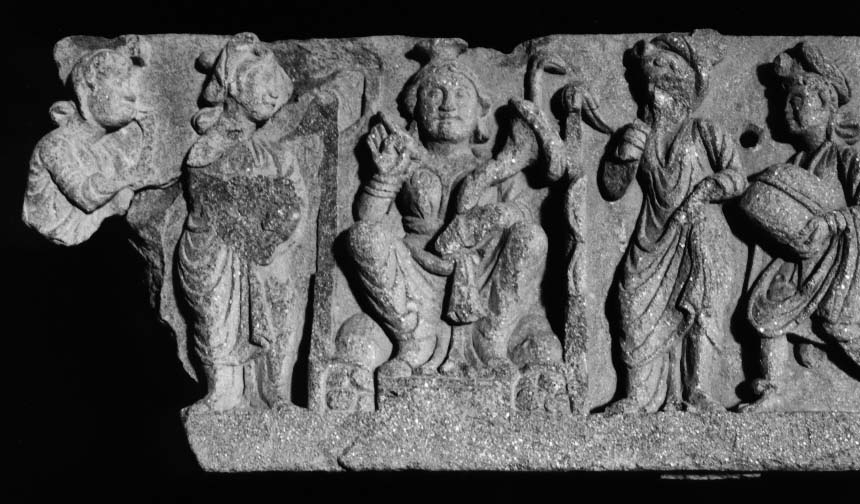 |
This panel relief shows five female figures. The lower left corner of the panel is missing so that the figure on the extreme left is represented only by upper half. The most prominent among the five is the central figure. She is seated on a cushion full of coins, some of which have slipped out the front. The throne back is ornamented with fluttering banners. The goddess holds a cornucopia with a dramatically flared upper rim in her left arm and performs sri mudra with her raised right hand. She is clad in chiton and himation and wears heavy earrings and a polos on her head. The flanking figures, in standing position, are symmetrically arranged - on each side a donor is accompanied by an attendant. The attendants carry donations in covered baskets. The donors appear well-dressed and prosperous, indicating affiliation with a privileged social stratum.
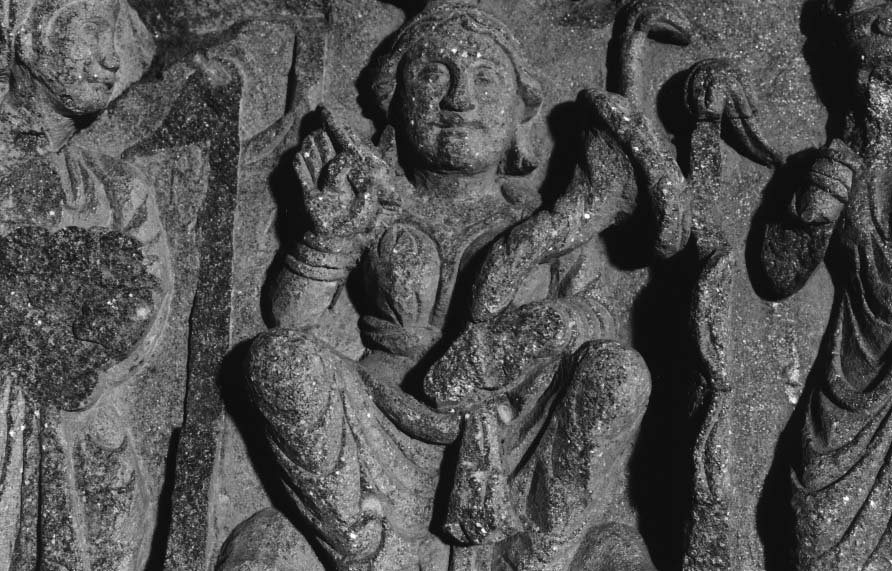 |